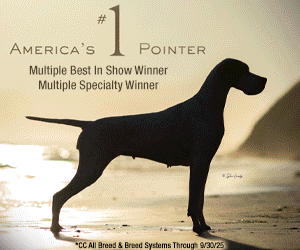The Buzz About Doberman Pinschers – Breeding For Correct Temperament Requires Testing And Evaluation
By: Nancy E Christensen / Renejade Dobermans
A breeder cannot know the strong and weak points of a dog’s temperament unless s/he tests drive levels, resilience, compliance, nerve and the like; any more than the breeder can breed for correct conformation without knowing exactly what correct conformation is and how to evaluate the strong and weak points when choosing breeding pairs.
Is the breeder trusting luck when breeding for a correct head? That is exactly the method that is too often employed with temperament. Everyone has heard “Of course he will protect me/my house/my car; he is a Doberman!”
So many breeders have no idea how to properly define and evaluate the aspects of temperament and character. Because of this, they are often fooled into thinking a dog has a “good” temperament – out of ignorance or delusion.
Example:
- Dog “A” is fearful of gunfire (gun sensitive)
- Dog “B” has never been exposed to gunfire
- Does this mean Dog “B” is not gun sensitive?
- Does knowing Dog “A” is gun sensitive mean he shouldn’t be bred? Should the breeder choose Dog “B” instead, since he is not known to be gun sensitive?
There is no way to know if Dog “B” is gun sensitive or not without testing. The breeder will be able to make a better breeding choice only if both dogs are tested.
The breeder must test and must know the parameters of correct temperament. If the breeder believes correct temperament is really an important goal, the breeder will find/make the time to test and evaluate.
There are many methods of evaluation.
Levels of testing range from simple observations in the home to the highest levels of competition. Again, the breeder must define the parameters that are important to him/her, while still remaining within the definitions of correct.
Departing from the Standard in temperament is not only incorrect; it has a profound effect on breed type.
DOBERMAN TEMPERAMENT, per the Standard:
Energetic, watchful, determined alert, fearless, loyal and obedient. The judge shall dismiss from the ring any shy or vicious Doberman.
Testing will help identify levels of compliance, resilience, focus, concentration, attitude, learning ability and learning retention. For those willing to commit to the highest levels, testing can also include evaluating the grips (full? calm? hard?), response to pressure from the environment, the handler or the helper. Response to pressure includes displacement behaviors, recovery from stress and clear-headedness.
The Working Aptitude Evaluation (WAE, http://dpca.org/awards/wae/index.php) is a baseline method of testing and gaining information. The observations made during the test are more important than if the dog should pass or fail. Different parts of the WAE test sociability, sound sensitivity, sight sensitivity, recovery from stress, compliance and recognition/response to a threat.
Training towards the goal of a defined title provides more information. The *real* reason (aside from personal enjoyment) for working a dog in any performance event, is not “can the dog title?” or how many titles can be attained. The *real* reason is so that the BREEDER can learn about temperament and drives within a consistent set of performance requirements.
The higher the level of training, the more information will be gained. If a dog is never trained to jump, you cannot know what the response and recovery is when the dog hits a jump. Until a dog falls from a dogwalk, you don´t know what his reaction will be or the effect it will have on attitude, recovery time and willingness to continue working.
A dog that is never tested will never show weakness. However, it will never show strength.
The key to training is not what titles the dog/handler team accomplish or how quickly, nor are the scores of highest importance. The real key to training in the higher levels (CDX and UD levels, advanced agility, protection sports) is what the handler learns about the dog through the training. Until the training advances past the basics, it is difficult (if not impossible) to separate and identify the drive levels in order to really evaluate temperament. Many trainers have no idea of the difference between a dog working in prey or play, or the difference between a dog challenging the handler through displacement behavior or through rank drive.
In training, it is important to learn about more than just one´s own dog. Attending a class or club situation is one of the best ways to accomplish this. A group situation gives the handler a great deal of information. The handler has the opportunity to see a variety of dogs (usually different breeds and ages) in a working environment, thus being able to observe some of the many combinations of drives and training methods that work (and don´t work) on each. Usually the handler is far less biased in evaluating the drives of someone else´s dog than their own! Eventually, the handler realizes that it is far easier to understand what the dog’s is and deal with it, than to make excuses. At that point, the breeder is able to begin to know what they want and do not want to accomplish as a breeder in a far more precise manner than before they were training, and they have the tools to make more precise evaluations.
Comments and questions are welcome and can be directed to the DPCA Corresponding Secretary, Sandy Teague at DPCAcorrespondingsecretary@dpca.org or to DPCAPublicEducation@dpca.org.
About the Author: Nancy Christensen is an AKC Judge of Dobermans and has owner-bred, -trained, and -handled Dobermans successfully in conformation, schutzhund, tracking, obedience, agility and flyball since first falling in love with the Breed in 1974.
*Photos courtesy of Doberman Pinscher Club of America, photos submitted by members with no attribution, only a desire to showcase the versatile and magnificent Doberman Pinscher, an American hero and good citizen.
Short URL: http://caninechronicle.com/?p=26370
Comments are closed













